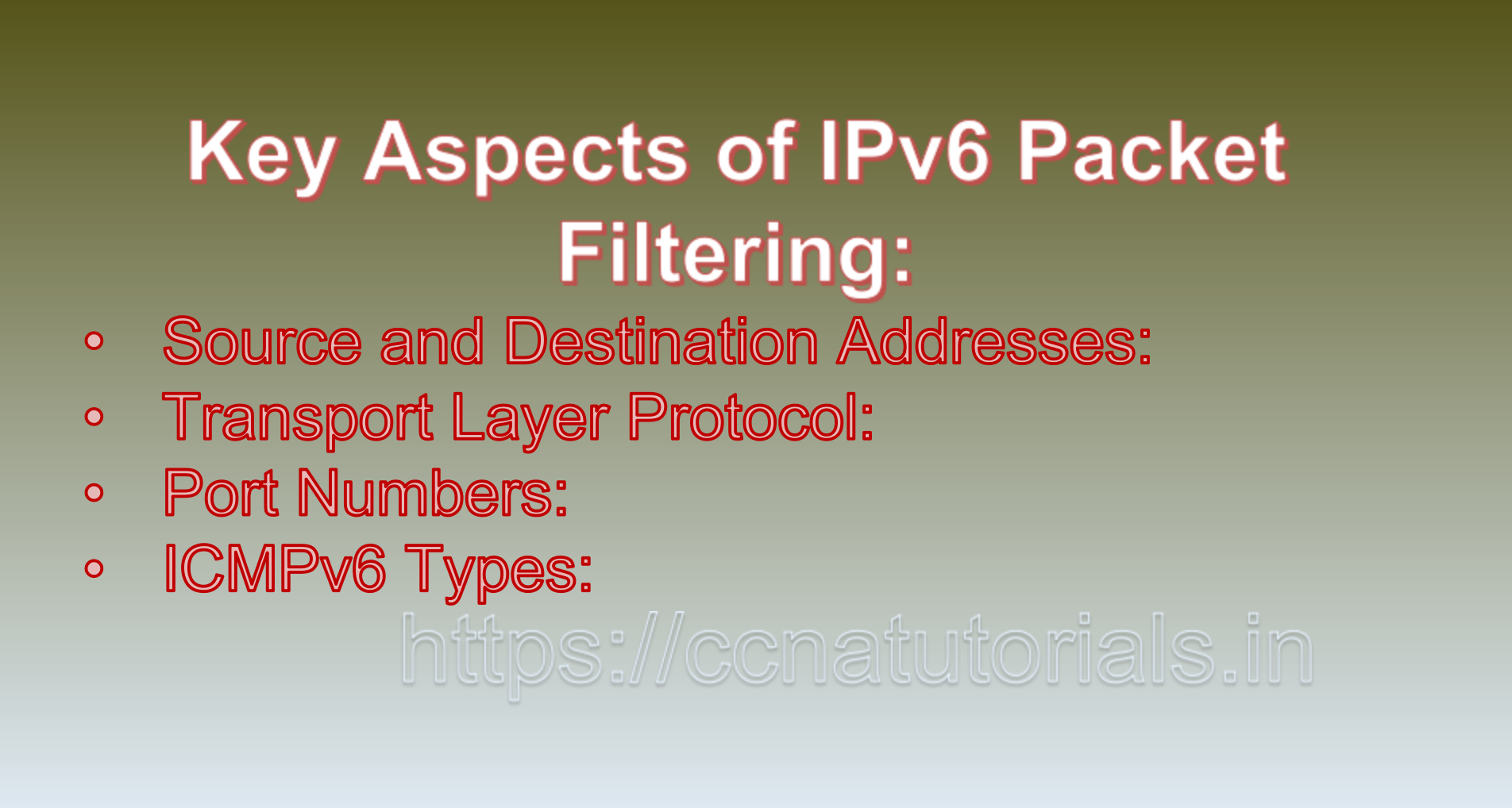Contents of this article
In this article, I describe IPv6 Packet Filtering and Filtering Rules: Safeguarding Networks with Precision. IPv6 packet filtering is a critical component of network security that allows administrators to selectively permit or deny the flow of packets based on predefined criteria. Filtering rules serve as a powerful defense mechanism against unauthorized access, malicious attacks, and unwanted traffic. In this article, we explore IPv6 packet filtering, delve into the structure of filtering rules, and provide real-world examples to illustrate their importance and application.
IPv6 Packet Filtering:
IPv6 packet filtering involves analyzing incoming and outgoing packets at the network layer and making decisions about whether to allow or block their transmission based on specified criteria. Filtering rules determine the fate of packets as they traverse network devices, such as routers, firewalls, and intrusion detection systems (IDS).
Key Aspects of IPv6 Packet Filtering:
1. Source and Destination Addresses:
Filtering rules can be based on source and destination IPv6 addresses. This allows administrators to control communication between specific hosts or networks.
2. Transport Layer Protocol:
Filtering can be based on the transport layer protocol, such as TCP, UDP, or ICMPv6. This enables administrators to regulate traffic based on the type of protocol being used.
3. Port Numbers:
For TCP and UDP traffic, filtering rules can be defined based on source and destination port numbers. This helps control specific services and applications.
4. ICMPv6 Types:
Filtering can target specific ICMPv6 message types, allowing administrators to manage network diagnostics and error messages.
5. Interface:
Filtering rules can be applied to specific network interfaces, helping manage traffic based on the point of entry or exit.
Filtering Rules:
Filtering rules dictate the conditions under which packets are either accepted or rejected. These rules are defined using a combination of criteria that reflect the desired security policy of the network. Each rule consists of conditions that match packet attributes and an action to be taken if the conditions are met.
Components of a Filtering Rule:
1. Source Address: The source IPv6 address or network from which the packet originates.
2. Destination Address: The destination IPv6 address or network to which the packet is directed.
3. Protocol: The transport layer protocol (e.g., TCP, UDP, ICMPv6) used in the packet.
4. Source and Destination Ports: For TCP and UDP packets, the source and destination port numbers.
5. ICMPv6 Type: For ICMPv6 packets, the specific ICMPv6 message type.
6. Action: The action to be taken if the packet matches the conditions. Common actions include “permit” (allow) and “deny” (block).
Example Scenarios for IPv6 Packet Filtering and Filtering Rules:
1. Permitting Outbound Web Traffic:
An organization wants to permit outbound web traffic (HTTP) from its internal network to the Internet while blocking all other outbound traffic. The following rule could be implemented:
– Rule: Permit outbound traffic from internal network to any destination IP address using TCP port 80 (HTTP).
– Action: Permit the packet.
2. Denying ICMPv6 Echo Requests (Ping):
An organization decides to block ICMPv6 Echo Request messages (ping) to enhance network security. The following rule could be employed:
– Rule: Deny incoming packets with ICMPv6 type 128 (Echo Request).
– Action: Deny the packet.
Importance of IPv6 Packet Filtering and Filtering Rules:
1. Network Security:
Filtering rules safeguard networks from unauthorized access, malicious attacks, and undesirable traffic, reducing the risk of breaches and data leakage.
2. Traffic Control:
Packet filtering enables administrators to manage network traffic, ensuring that critical services operate smoothly while potentially harmful activities are mitigated.
3. Compliance:
Filtering rules help organizations adhere to regulatory requirements by controlling access to sensitive resources and enforcing security policies.
4. Optimized Performance:
Packet filtering prevents unnecessary or unwanted traffic from consuming network resources, optimizing network performance.
5. Protection against Vulnerabilities:
Filtering rules protect against known vulnerabilities and attacks by blocking specific types of traffic that could exploit weaknesses.
In short IPv6 Packet Filtering and Filtering Rules:
IPv6 packet filtering and filtering rules are integral to network security and management. By strategically defining and applying filtering rules, organizations can establish granular control over the flow of packets, safeguarding their networks against threats and unauthorized access. Filtering rules play a crucial role in enforcing security policies, optimizing performance, and maintaining compliance with industry regulations. As the digital landscape continues to evolve, mastering IPv6 packet filtering and its associated rules becomes a paramount task for network administrators to ensure the integrity and safety of network operations.

IPv6 Packet Filtering and Filtering Rules: Enhancing Network Security
IPv6 packet filtering is a critical aspect of network security that involves selectively allowing or blocking packets based on predefined filtering rules. Filtering rules are used to specify conditions that packets must meet in order to be forwarded or dropped by a router or firewall. This process helps organizations safeguard their networks from unauthorized access, malicious traffic, and potential threats. In this article, we delve into the concept of IPv6 packet filtering, explore filtering rules, and provide real-world examples to illustrate their significance.
IPv6 Packet Filtering:
IPv6 packet filtering is the practice of inspecting packets as they traverse network devices, such as routers or firewalls, and making decisions about whether to allow or discard them. Filtering decisions are based on a set of predefined rules that define criteria such as source and destination IP addresses, ports, protocols, and other packet attributes.
Key Components of IPv6 Packet Filtering:
1. Rules:
Filtering rules are the core of packet filtering. These rules define the conditions under which packets will be accepted or rejected.
2. Action:
Each filtering rule specifies an action to be taken if a packet matches the rule’s conditions. The actions can include allowing the packet to pass, dropping the packet, or logging information about the packet.
3. Matching Criteria:
Filtering rules are based on various packet attributes, including source and destination IP addresses, port numbers, protocol types, and more.
4. Order:
Rules are usually processed in order, with the first matching rule determining the fate of the packet. The order of rules can significantly impact filtering outcomes.
Filtering Rule Examples:
1. Allowing Inbound Web Traffic:
Consider a scenario where an organization wants to allow incoming HTTP traffic (port 80) from the Internet to a specific server on its IPv6 network. A filtering rule can be defined as follows:
– Rule: Allow incoming IPv6 packets with a destination port of 80 (HTTP) to the server’s IPv6 address.
– Action: Permit the packets to reach the server.
– Example Rule:
“`
Allow IPv6 Inbound Traffic from Any to [Server IPv6 Address] Port 80
“`
2. Blocking Unauthorized SSH Access:
An organization aims to block any SSH traffic (port 22) originating from outside its internal network. A filtering rule can be configured to achieve this goal:
– Rule: Block incoming IPv6 packets with a source port of 22 (SSH) from external IP addresses.
– Action: Drop the packets to prevent unauthorized SSH access.
– Example Rule:
“`
Block IPv6 Inbound Traffic from [External IP Address Range] to Any Port 22 (SSH)
“`
Importance of IPv6 Packet Filtering and Filtering Rules:
1. Network Security:
IPv6 packet filtering serves as a crucial line of defense against unauthorized access, denial-of-service attacks, and other security threats.
2. Traffic Control:
Filtering rules allow organizations to control the types of traffic that are allowed into or out of their networks, optimizing resource utilization.
3. Compliance:
Packet filtering helps organizations meet regulatory and compliance requirements by enforcing access control and security policies.
4. Resource Protection:
By filtering out malicious or unnecessary traffic, organizations can protect their network resources and ensure that they are used efficiently.
Conclusion IPv6 Packet Filtering and Filtering Rules:
IPv6 packet filtering and filtering rules play a vital role in enhancing network security and controlling traffic flow within organizations’ networks. These rules allow organizations to define specific criteria for accepting or blocking packets, based on attributes like source and destination IP addresses, port numbers, and protocols. Real-world examples illustrate how filtering rules can be applied to allow or block specific types of traffic. As organizations continue to adopt IPv6 and face evolving security challenges, mastering the art of packet filtering and rule-based decision-making becomes essential for building resilient and secure network infrastructures. You may drop a comment below or contact us for any query or suggestions related to this article.






